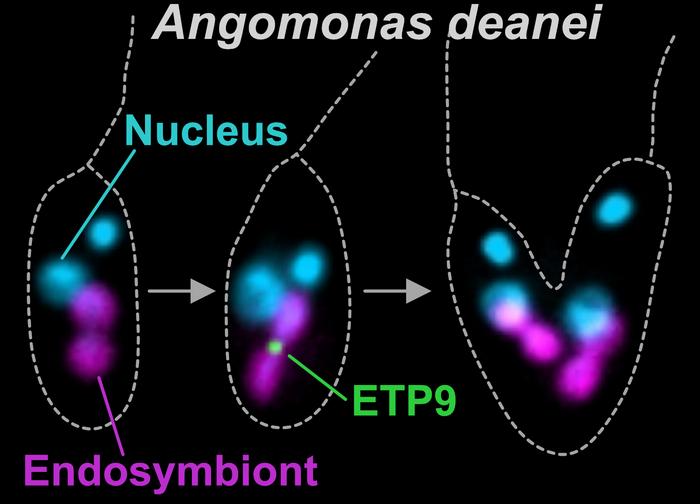The intricate relationship between host cells and their endosymbionts has captivated researchers for decades, illuminating the evolutionary dynamics that underpin cell biology. A pioneering study led by Professor Dr. Eva Nowack at Heinrich Heine University Düsseldorf sheds light on a remarkable case of symbiosis involving the trypanosomatid organism Angomonas deanei. The investigation reveals how this single-celled flagellate, which thrives within the intestines of insects, has formed a synthetic to symbiotic relationship with a protobacterium that served as its endosymbiont. These findings not only elucidate the mechanisms of evolution but also offer novel insights into the functionality and behavior of organelles.
Understanding the essential characteristics of endosymbionts is pivotal in grasping the evolution of eukaryotic cells. Initially, these organelles operated independently as unicellular entities before their incorporation into host cells. Over time, as they adapted and evolved alongside their hosts, they relinquished their autonomy, becoming integral components of the cellular machinery. The jury is still out on precisely how quickly or uniformly this assimilation process occurs, yet the research presented by Professor Nowack’s team provides a snapshot of an essential intermediate stage.
Professor Nowack points to the evolutionary history of the Strigomonadinae sub-family as indicative of the complex relationships forged among these tiny organisms. The team posits that approximately 40 to 120 million years ago, a common ancestor of Strigomonadinae initiated a significant evolutionary event by engulfing a protobacterium. This act was not merely a case of phagocytosis but a calculated relationship that resulted in a dynamic exchange of metabolites and co-factors designed to aid in various enzymatic processes. What’s fascinating here is that Angomonas deanei hosts only one of these endosymbionts, which perpetually divides in synchronization with the host cell’s cycle.
The essence of this study lies in the finding that certain host-derived proteins play an instrumental role in facilitating the division of the endosymbiont. Central among these is ETP9, a nucleus-encoded protein that orchestrates the division of the endosymbiont. This heralds a paradigm shift in our understanding of cellular division by emphasizing the interplay between nucleus-encoded functions and organelle behavior. Through their meticulous research, Nowack and her team discovered that an absence of ETP9 leads to an inability of the endosymbiont to divide effectively, resulting in a phenomenon where one cell manifests multiple division sites.
A striking aspect of the study is the identification of a significant loss of genetic material in the endosymbionts over time. Genetic remnants suggest that the endosymbionts in Angomonas deanei are almost entirely devoid of the genetic prerequisites for independent cell division, except for the essential gene encoding the protein FtsZ. This bacterial vestige serves as a reminder of the endosymbiont’s ancestral lineage, whereby genetic self-sufficiency has been gradually supplanted by reliance on host functions.
Through experimental interventions, the researchers orchestrated a situation where the production of ETP9 was halted, resulting in the emergence of abnormally elongated endosymbionts that could no longer divide independently. These endosymbionts, characterized by multiple marked division sites by the FtsZ protein, starkly illustrate the extensive evolutionary regression from autonomy to dependence. Thus, Angomonas deanei serves as a living laboratory, teetering on the threshold between a semi-autonomous bacterium and a fully integrated organelle.
The implications of these findings extend beyond mere academic interest, offering glimpses into the future of bioengineering and synthetic biology. If the evolutionary trajectory observed within Angomonas deanei can be harnessed and replicated, it could pave the way for the creation of synthetic endosymbionts controlled by host nuclei. Such advancements hold promise for groundbreaking applications in medicine, environmental sciences, and biotechnology, pushing the limits of our current understanding of symbiosis.
Interactions between endosymbionts and their hosts are not merely incidental; rather, they represent a systematic integration of functions and evolutionary benefits that enhance cellular capabilities. The communication between the host genome and the endosymbiont genome is a key area of exploration. The ability for host cells to incorporate and regulate elements of an endosymbiont’s biology illustrates a sophisticated level of genetic and functional coordination that may have deep implications for evolutionary biology.
As researchers delve deeper into the cellular underpinnings of symbiosis, the work surrounding Angomonas deanei serves as a poignant reminder of the complex dance between different life forms. Each little action within the cell contributes to the overarching narrative of evolution and inter-species collaboration. The study’s findings in Science Advances are likely to stimulate further interest and research in the endosymbiotic process, provoking questions about other mutually beneficial relationships across the biological spectrum.
In conclusion, the innovative work conducted by Nowack and her collaborators at Heinrich Heine University Düsseldorf significantly enhances our comprehension of cellular evolution, particularly regarding the dynamic relationships between hosts and their endosymbionts. Their uncovering of the vital role that nucleus-encoded proteins play in endosymbiont division may redefine existing paradigms in cell biology and open up new avenues for scientific exploration. The evolutionary story told through Angomonas deanei is ongoing, rich with potential discoveries waiting to be unearthed.
As researchers continue to unveil the subtle complexities inherent in cellular relationships, the emerging knowledge paints a broader picture of how life has evolved under the constraints and benefits of symbiosis. Each study contributes a brick to the immense structure of our understanding of biological interdependence, offering critical insight into the very fabric of life itself.
Subject of Research: Evolution of endosymbionts in Angomonas deanei
Article Title: A nucleus-encoded dynamin-like protein controls endosymbiont division in the trypanosomatid Angomonas deanei
News Publication Date: 19-Mar-2025
Web References: Science Advances
References: DOI: 10.1126/sciadv.adp8518
Image Credits: HHU/Anay Maurya and Eva Nowack
Keywords: Endosymbiosis, Organelles, Evolution, Cellular Biology, Symbiosis




